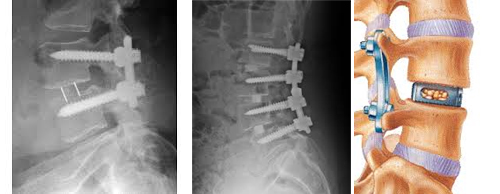Lumbar Spinal Fusion TLIF PLIF
Spinal fusion is a technique used to stabilize the spinal bones or vertebrae. The goal of lumbar fusion is to create a solid bridge of bone between two or more vertebrae. Spinal fusion may be recommended when the natural disc space has decreased or the spine is unstable. Lumbar spinal fusion refers to back surgery during which two or more vertebral segments of the spine are fused together. Interbody fusion involves placement of fusion implants and bone graft into the area between two vertebral bodies and is an effective method for achieving fusion. The intervertebral implant may be made from a variety of materials including metal, plastic, or bone. Bone graft and bone healing protein may be placed within the implant and within the interbody space to encourage bony healing. The implant helps by separating and holding the two vertebrae apart. This increases the opening around the nerve roots at that level, relieving pressure on the nerves. The intervertebral implants can also be used to correct spinal deformity and restore proper alignment. Intervertebral implants can be placed from the front, side or back of the spine. The location of the surgery is dependent on the specific anatomy of each patient, as well as the location and amount of pressure that may be occurring around the nerves in the spinal canal. The decision is based on many factors including the patient’s anatomy, location of the levels that need to be fixed, degree of spinal instability, and prior abdominal surgery. Spinal fusion, also known as spondylodesis or spondylosyndesis.
The goal of lumbar fusion surgery is
- To relieve pain, numbness, tingling, and weakness,resort nerve function
- Stop or prevent abnormal motion in the spine
- Provide more space for the compressed spinal cord and nerve root to heal

Medical condition that may benefit from lumbar spinal fusion include
- Chronic low back pain
- Lumbar radiculopathy with disc prolapse and recurrent disc herniation/li>
- Lumbar canal stenosis
- Lumbar spondylolisthesis
- Degenerative lumbar spondylolisthesis
- Scoliosis, kyphosis
- Degenerative disc disease
- Spinal tumors
- Vertebral fractures
- Scheuermann’s disease
Quick Facts About Lumbar Spinal Fusion TLIF PLIF
- Duration Of Surgery: 3-4 hours. Also depends on the level of fusion may take additional 30 min. to 1 hr for additional each level.
- Anaesthesia: General Anaesthesia
- Length Of Hospital Stay: 3-5 days including 1 day of ICU care . Most of the patients usually get out of bed and walk on the next day of surgery. Most patients go home within 3-5 days after surgery.
Recovery
The success rate for a TLIF / PLIF approximately 90% to 95%, although 5% of patients may develop implant failure , neurological deficit or recurrence of the symptoms. Smoking is strictly prohibited.
Scars
Depends on the level to be operated and may vary from 5 cm. for a single level to 3-4 cm. extra at each additional level.
Can also be done minimally invasively with a small scar in selected cases.
Possible Risks/Complications
Risks and potential complications associated with a TLIF / PLIF include
- Dural tear (cerebrospinal fluid leak) -1-2%
- Nerve root damage
- Non-union and pseudoartrosis
- Bowel/bladder incontinence
- Bleeding
- Infection
- Implant failure
- Death(very rare)
- Smoking should be stopped

